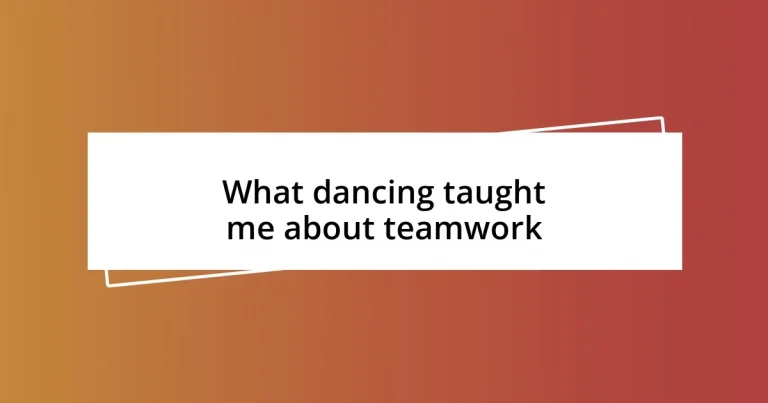Key takeaways:
- Teamwork in dance fosters strong bonds through shared experiences, enhancing trust and communication among dancers.
- Effective communication, including non-verbal cues and active listening, is crucial for adapting and resolving conflicts during performances.
- Facing challenges together, such as financial barriers or last-minute changes, strengthens teamwork and demonstrates the power of collaboration.
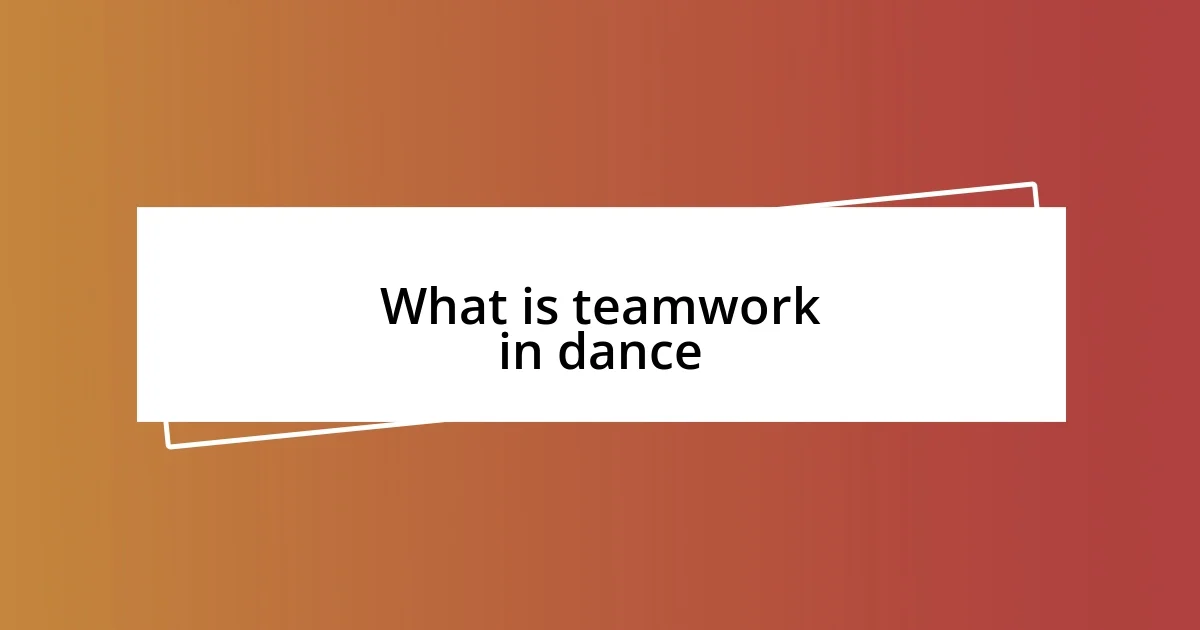
What is teamwork in dance
Teamwork in dance is about merging individual strengths for a collective performance. I still remember my first dance recital, where I felt a rush of adrenaline as I synchronized my movements with fellow dancers. It’s fascinating how, as we moved in unison, each step became a testament to collaboration, bridging our unique styles into a cohesive expression of art.
When I reflect on intense rehearsals, I can’t help but feel that the emotional highs and lows we experienced together only deepened our bond. The moments of joy, the shared frustration when things didn’t go as planned, and the exhilarating sense of achievement once we nailed a routine are invaluable. How can such moments not highlight the essence of teamwork? It teaches us to rely on and uplift one another, creating an unspoken connection that transcends the actual dance.
Moreover, I’ve often found that communication plays a crucial role in our routines. It’s not just about following someone else’s lead; it’s about anticipating your partner’s moves and adjusting accordingly. I recall a duet where I had to adjust my timing because my partner stumbled slightly. Instead of breaking the rhythm, we instinctively adapted. Isn’t it powerful how, in those fleeting seconds, teamwork turns a potential mishap into an opportunity for growth?
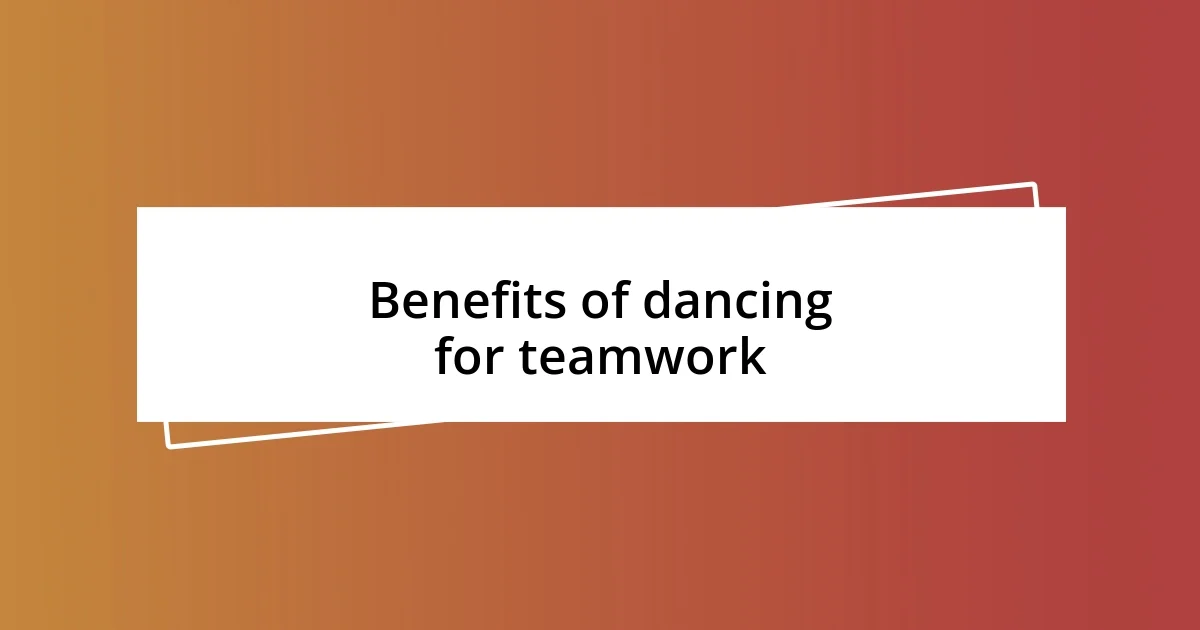
Benefits of dancing for teamwork
The benefits of dancing extend far beyond the music and movements; they significantly enhance teamwork skills. Through my experiences, I learned that dancing requires not just physical coordination, but also mental agility. I vividly remember a group dance where we had to create a seamless transition between different formations. We spent hours brainstorming together, communicating our ideas, and ultimately it was our willingness to listen to each other that led to a stunning performance. This collaboration helped me realize how crucial communication practices translate into any team setting, fostering trust and connection.
Focusing on the essential benefits, here are a few key aspects that dancing teaches about teamwork:
- Enhanced Communication: Learning to express feelings and ideas non-verbally through movement develops a deeper understanding of unspoken cues.
- Trust Building: Relying on fellow dancers to support and catch you during lifts fosters profound trust that can translate into any team environment.
- Conflict Resolution: Navigating mistakes during practice sessions teaches how to discuss issues constructively and adapt quickly.
- Creativity and Problem-Solving: Choreographing new routines as a group encourages creative collaboration and innovative thinking.
- Shared Responsibility: Each dancer must pull their weight for the performance to succeed, instilling a sense of collective ownership among the team.
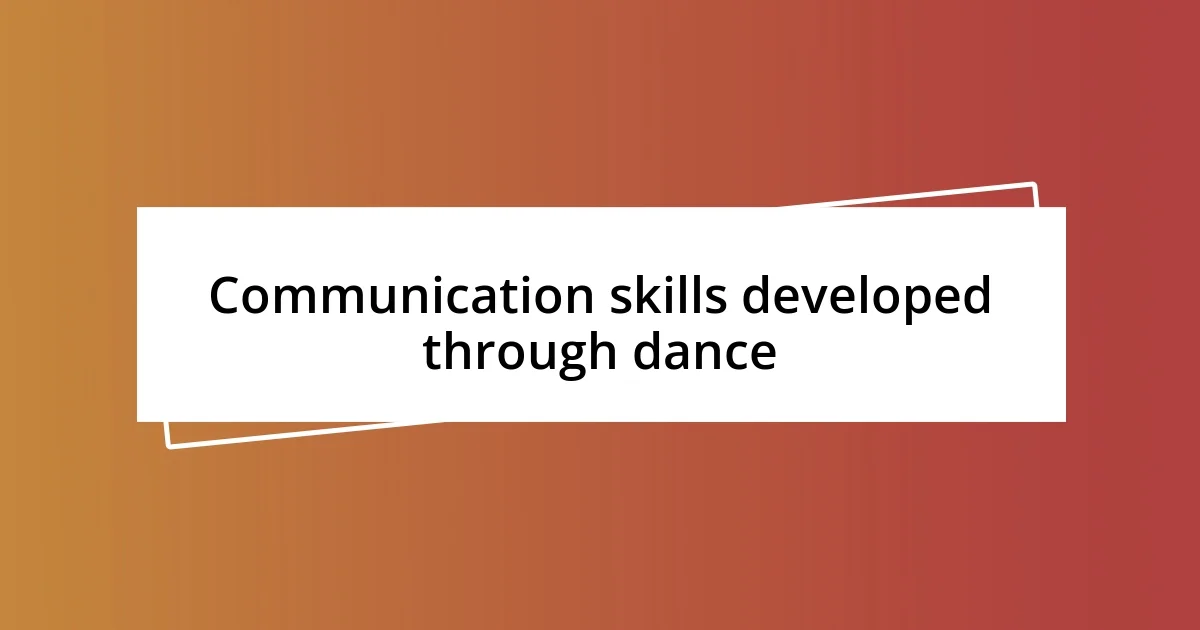
Communication skills developed through dance
Engaging in dance taught me that communication is often more than just words; it’s an art form in itself. I remember preparing for a particularly complex choreography. During one rehearsal, rather than verbal instruction, we relied on subtle eye contact and body language to convey adjustments. I felt an exhilarating sense of connection; we became almost like a well-oiled machine, able to communicate effectively without uttering a single word. Isn’t it fascinating how non-verbal cues can enhance both performance and personal connections?
In dance, knowing your partner’s pace and style is crucial. I once partnered with a dancer who had a totally different rhythm; instead of letting our differences clash, we took time to communicate our individual styles openly. This deliberate conversation led to us blending our movements fluidly. Each adjustment we made wasn’t merely physical; it felt like a conversation where we learned the nuances of each other’s strengths. How did that change the way we performed? The dance flowed more naturally, allowing us to create something unique together.
Finally, I discovered that communication in dance also fosters emotional intelligence. During a group performance, I noticed that when one member was off or struggling, others would instinctively adjust their energy. I felt a strong sense of empathy in those moments. We became attuned not just to the music, but to each other’s feelings. This heightened awareness is a beautiful reminder that effective communication transcends words, building deeper connections both on and off the stage.
| Communication Aspect | Example in Dance |
|---|---|
| Non-Verbal Cues | Using eye contact and body language to signal changes during choreography |
| Active Listening | Open dialogue about individual styles to merge rhythms |
| Emotional Intelligence | Adjusting energy levels based on team members’ needs during performance |
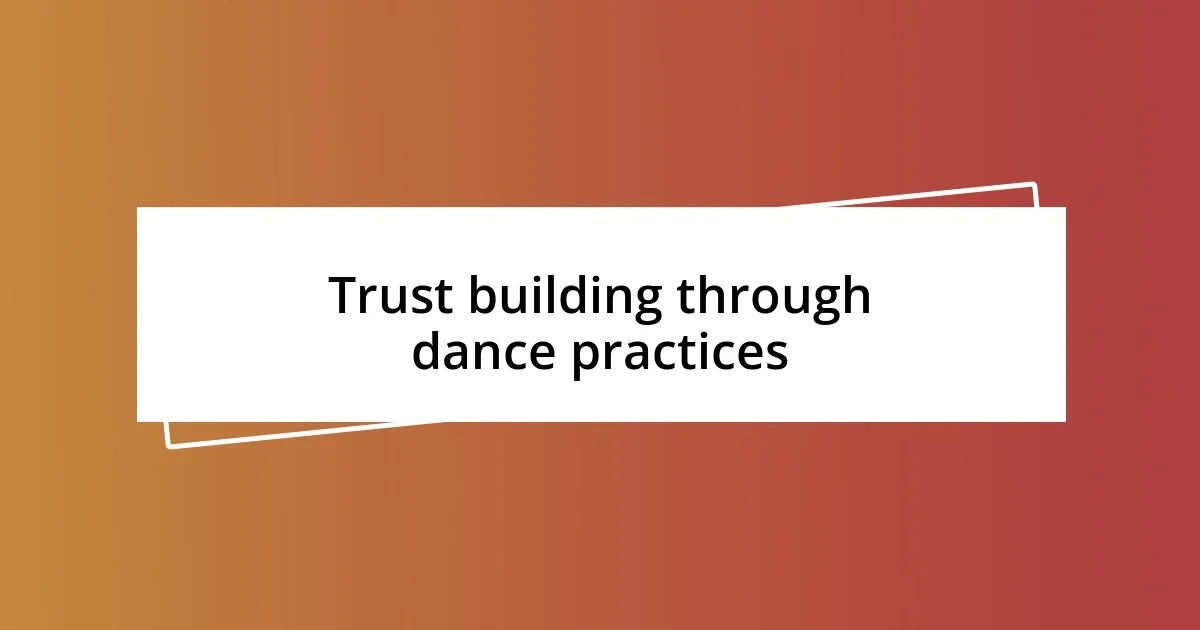
Trust building through dance practices
When I think about trust building in dance practices, I recall one instance where we were preparing for a performance that included a challenging lift. I remember feeling nervous about whether my partner could catch me safely. However, as we worked together, repeatedly practicing the lift, I began to feel that nervousness melt away. It was in those moments of lifting and supporting each other that I experienced firsthand how trust can be cultivated through consistent practice and open communication.
There was a time when we were rehearsing a group routine, and one of our members struggled with a key move. Instead of getting frustrated, we gathered around and offered encouragement, sharing tips we had used to master it ourselves. I realized then how vital it is to create an environment where everyone feels safe to express vulnerability. This dynamic fostered not just trust, but a sense of belonging. Who knew that a simple dance team could become such a strong support system?
Trust in dance isn’t just about physical support; it’s about creating strong connections. One evening, while practicing in pairs, we were challenged to improvise a duet. I hesitated at first, worried about what my partner would think if I stumbled. But as we explored the rhythms together, I found that letting go of those fears allowed us to connect deeply. The more we trusted ourselves to be creative and vulnerable, the more beautiful our movements became. Isn’t that the essence of teamwork? Trust isn’t built overnight; it’s nurtured through shared experiences and collective growth.

Conflict resolution in dance settings
Dancing inherently involves collaboration, which sometimes leads to friction among team members. I’ll never forget a rehearsal when two dancers clashed over the interpretation of a specific movement; tensions were high, and their frustration was palpable. Rather than letting animosity take over, the group decided to hold an open discussion, where everyone shared their viewpoints. This dialogic approach transformed the situation; what began as heated disagreement turned into a rich conversation, allowing us to blend different ideas into a cohesive performance. Have you ever noticed how simply talking things out can resolve conflict in unexpected ways?
Another instance stands out in my mind when we faced a challenge during a group number, where the timing of our movements felt off. Instead of pointing fingers, we took a moment to recalibrate together. We circled up, assessed the root of the problem, and, in that collaborative space, I saw vulnerabilities surface. To witness everyone admit their struggles helped us unify our efforts. The result? A harmonious dance that felt more authentic than it ever could have if we had continued to gloss over our issues. Isn’t it interesting how embracing conflict can lead to stronger team bonds?
One lesson I learned is that conflict can actually spark creativity. I remember a time when our choreography felt stagnant, and I sensed that the team was disengaged. In response, I proposed a “creative conflict” session, where each dancer brought new ideas and interpretations to the table. Initially, the discussion was a bit chaotic, but as ideas flowed, we realized how different perspectives could transform our routine. This experience helped me grasp the importance of viewing conflict as a catalyst for invention rather than a roadblock. Have you ever experienced a similar moment of breakthrough when you least expected it?
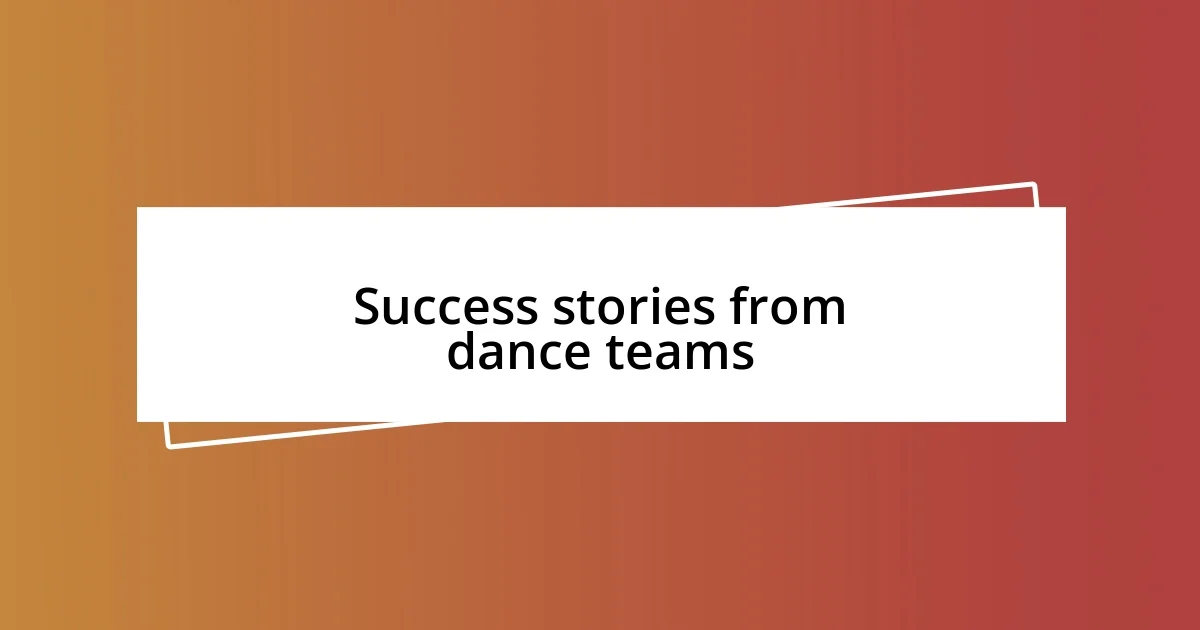
Success stories from dance teams
One standout success story from my dance team revolves around a community performance that brought us all together. A few months before the event, we discovered that funding was tight, and some of our dancers faced financial barriers to participate. Rather than letting that discourage us, we organized fundraisers and pooled our resources. Not only did we manage to cover costs for everyone, but we also deepened our bond as we worked toward a common goal. It’s amazing how adversity can ignite a sense of unity, don’t you think?
During one competition, our team was up against some tough rivals, and honestly, we felt the pressure. I vividly remember the moment we stepped onto the stage. Instead of getting caught up in anxiety, we took a collective breath, reminded each other of our hard work, and echoed our mantra—“Together we shine.” That performance ended up being one of our best yet, leaving the audience cheering. It struck me then that confidence stems not from perfection but from the connection we build together. Have you ever experienced that kind of electric synergy with a team?
Reflecting on my journey with dance, I often think of the countless times we faced setbacks. Once, a last-minute injury meant we had to change our entire routine the night before a show. The team came together, adjusting choreography and even teaching each other new parts. What could have been a disaster turned into a triumphant moment where we showcased not just our skills, but our adaptability and teamwork. It was a testament to the power of collaboration. How often do we underestimate the collective strength of a group in the face of challenges?












